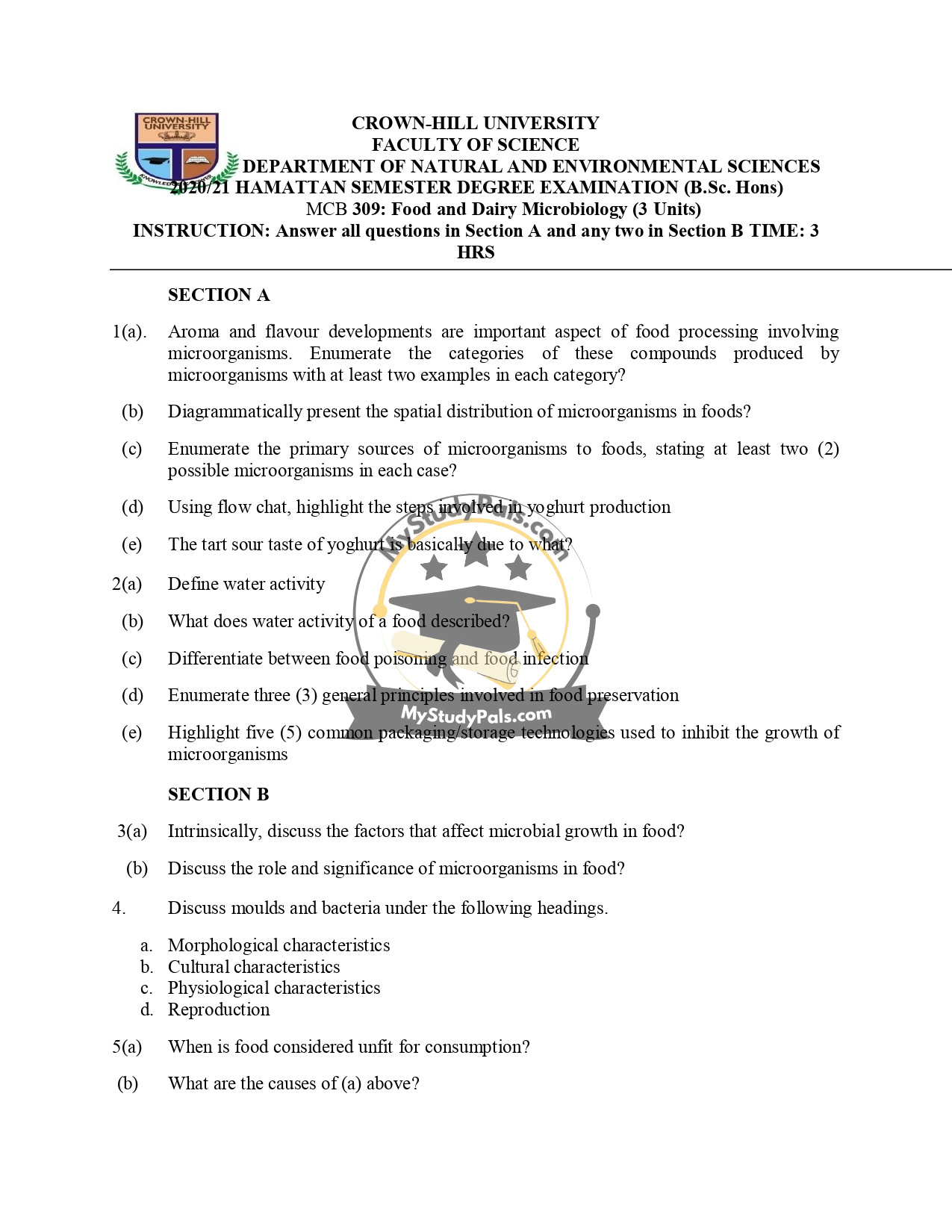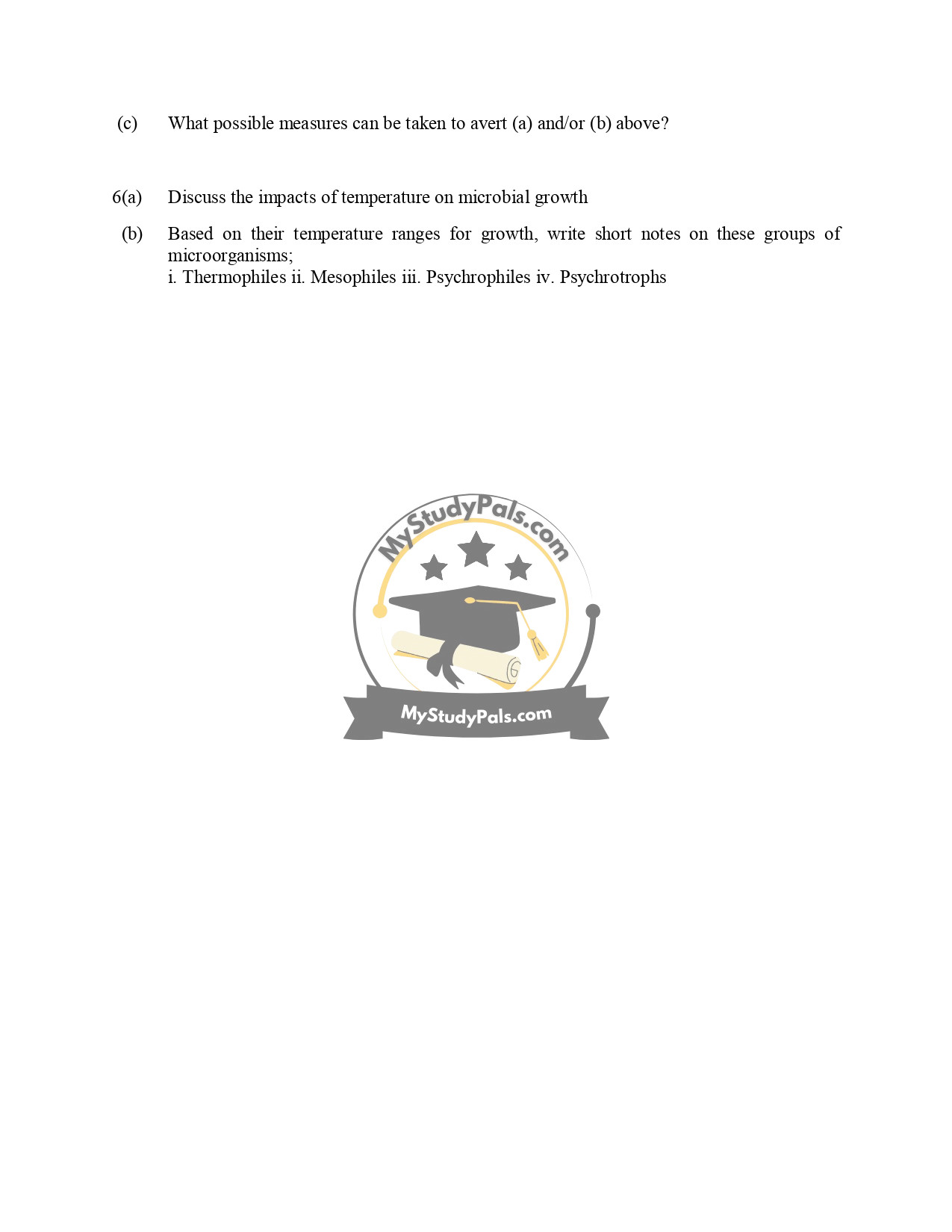ANWSER
—
### SECTION A
#### Question 1(a):
Answer:
Categories of aroma and flavor compounds produced by microorganisms:
1. Alcohols (e.g., ethanol, butanol)
2. Aldehydes (e.g., acetaldehyde, diacetyl)
3. Ketones (e.g., acetone, acetoin)
4. Esters (e.g., ethyl acetate, isoamyl acetate)
5. Organic Acids (e.g., lactic acid, acetic acid)
—
#### Question 1(b):
Answer:
Spatial Distribution of Microorganisms in Foods:
[Diagrammatic representation would show:]
– Surface contamination (e.g., molds on bread)
– Internal contamination (e.g., bacteria in meat)
– Uniform distribution (e.g., in liquid foods like milk)
—
#### Question 1(c):
Answer:
Primary Sources of Microorganisms in Foods:
1. Soil (e.g., *Clostridium*, *Bacillus*)
2. Water (e.g., *Vibrio*, *Pseudomonas*)
3. Plants (e.g., *Lactobacillus*, *Erwinia*)
4. Animals (e.g., *Salmonella*, *Staphylococcus*)
5. Air (e.g., molds, yeasts)
—
#### Question 1(d):
Answer:
Flowchart for Yoghurt Production:
1. Milk Collection → 2. Pasteurization → 3. Cooling → 4. Inoculation (Starter Cultures: *Lactobacillus bulgaricus* & *Streptococcus thermophilus*) → 5. Incubation (Fermentation) → 6. Cooling → 7. Packaging → 8. Storage
—
#### Question 1(e):
Answer:
The tart sour taste of yoghurt is due to lactic acid produced by bacterial fermentation.
—
#### Question 2(a):
Answer:
Water activity (a_w) is the measure of available water in food for microbial growth, expressed as the ratio of vapor pressure of food to pure water.
—
#### Question 2(b):
Answer:
Water activity describes the availability of water for microbial metabolic activities. Lower a_w inhibits microbial growth.
—
#### Question 2(c):
Answer:
– Food Poisoning: Caused by toxins produced by microbes (e.g., *Staphylococcus aureus*). Symptoms appear rapidly.
– Food Infection: Caused by consuming live pathogenic microbes (e.g., *Salmonella*). Symptoms take longer to manifest.
—
#### Question 2(d):
Answer:
Principles of Food Preservation:
1. Reducing water activity (drying, salting)
2. Temperature control (heating/cooling)
3. Chemical preservation (e.g., benzoates)
—
#### Question 2(e):
Answer:
Packaging/Storage Technologies:
1. Vacuum packaging
2. Modified Atmosphere Packaging (MAP)
3. Canning
4. Refrigeration
5. Aseptic packaging
—
### SECTION B
#### Question 3(a):
Answer:
Factors Affecting Microbial Growth in Food:
1. Intrinsic Factors: pH, water activity, nutrients, antimicrobial compounds.
2. Extrinsic Factors: Temperature, humidity, gaseous environment.
—
#### Question 3(b):
Answer:
Roles of Microorganisms in Food:
– Beneficial: Fermentation (e.g., yoghurt, cheese), probiotics.
– Harmful: Spoilage, pathogens (e.g., *E. coli*).
—
#### Question 4:
Answer:
Moulds vs. Bacteria:
| Characteristic | Moulds | Bacteria |
|————————–|————————————-|———————————-|
| Morphology | Filamentous, hyphae | Unicellular, rods/cocci |
| Cultural | Grow on low-a_w foods | Require higher moisture |
| Physiological | Aerobic, degrade complex organics | Some anaerobic, rapid growth |
| Reproduction | Spores (sexual/asexual) | Binary fission |
—
#### Question 5(a):
Answer:
Food is unfit if it is contaminated (pathogens/toxins), spoiled (off-odors/texture), or beyond shelf-life.
—
#### Question 5(b):
Answer:
Causes:
1. Microbial growth
2. Chemical degradation
3. Physical damage
—
#### Question 5(c):
Answer:
Preventive Measures:
1. Proper hygiene during processing.
2. Storage at correct temperature.
3. Use of preservatives.
—
#### Question 6(a):
Answer:
Temperature Impacts:
– Low Temp: Slows growth (psychrophiles thrive).
– Optimal Temp: Maximizes growth (mesophiles).
– High Temp: Kills microbes (thermophiles survive).
—
#### Question 6(b):
Answer:
Microbial Groups by Temperature:
1. Thermophiles: >45°C (e.g., *Geobacillus*).
2. Mesophiles: 20-45°C (e.g., *E. coli*).
3. Psychrophiles: <15°C (e.g., *Pseudomonas*).
4. Psychrotrophs: Grow at 0°C but prefer 20-30°C.
—










